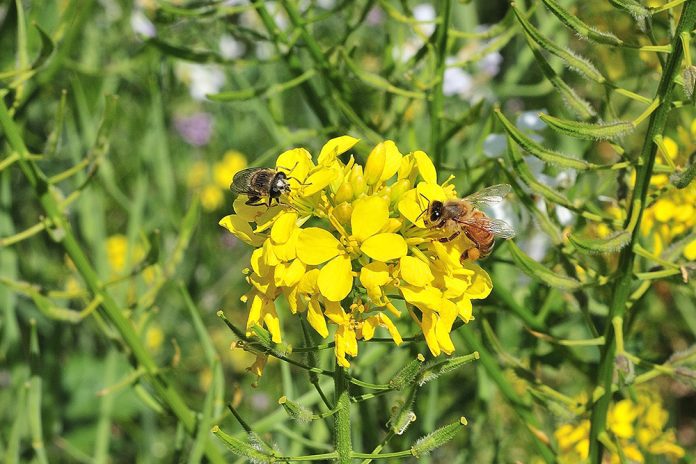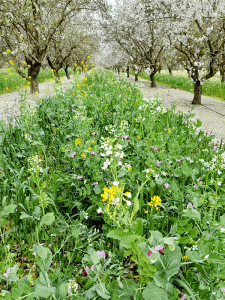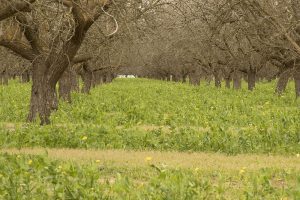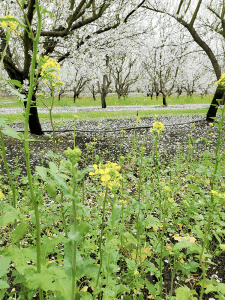
Will more California tree nut growers adopt a practice that many believe has management challenges but has been proven to have production benefits?
Cover cropping, the intentional planting and managing of a crop to cover the soil, is not a commonly adopted practice in the semi-arid Western States. According to the Soil Health Institute, less than five percent of farmland in the west has been planted to a cover crop, potentially due to uncertainties about water use and costs.
There are no recent reports on cover cropping in California tree nuts. California is ranked eighth in total cover crop growth from 2012 to 2017 with 6,198 farms using this practice, up from 4,899 reported in 2012. Rory Crowley, director of Habitat Programs for Project Apis m. said he believes 2% to 3% of tree nut acreage is intentionally planted, which is still behind California planting rates and well behind national percentages.
Considering the real or perceived challenges that come with a managed cover crop planted in orchards, it is understandable that growers have been hesitant in adopting this practice. Water use, residue management and frost damage are three reasons growers give for not planting a cover crop in their orchards. California’s varied growing environments and the many different management goals of growers and crop managers also present some specific challenges to cover cropping.
However, preliminary research and cover crop trials are showing benefits of planting cover crops in tree nut orchards. A survey conducted by Project Apis m. (PAm), an organization that funds research and efforts to improve honeybee health, found a major concern of almond growers is bee health. Soil health came in a close second. Crowley, in his article published in the July edition of West Coast Nut, said that even with the grower concern, survey data reveals growers are on the fence about cover crops in their orchards. Myths about water use and frost need to be challenged, he said.
1. Bee Health and Pollination Productivity
Almond growers in a survey chose this benefit as their number-one reason for planting cover crops in their orchards. They realize, Crowley said, that their production depends on healthy hives. Preliminary research by Almond Board of California shows that flowering cover crops can support bee health by providing nutrients and a natural habitat before, during and after almond bloom. Proper seed mix selection, planting timing and management are key to getting the most out of a cover crop.
Cover crops in an orchard do not compete with almond blooms for pollination. Almond Board-funded research suggests that cover crop presence does not lead to decreased yields due to competition for pollination between almond trees and cover crop.
Most of the honeybee colonies that arrive in California almond orchards for crop pollination are moved in January and have not had access to forage after overwintering. Project Apis m. reports that when foraging bees bring the first pollen of the year back to the hive, the bees inside the colony begin to rear larvae. The larvae emit a pheromone that stimulates bees to forage. Research also shows honeybee colonies reared in pollen limited conditions produce workers that forage less often and are less efficient at communicating, which could have a significant impact on pollination activity and crop yield.

2. Soil Health and Productivity
A study by researchers from UC Davis, Riverside and Berkeley looked at soil health components including physical, chemical and biological across three seasons of cover cropping in almond production. After a first cover crop season, soil analysis showed improved aggregate stability trends, particularly where a pollinator mix was planted at the Kern County trial site, which was heavily compacted.
The study also found that a seeded cover crop can contribute more nitrogen to an orchard soil than resident vegetation. Compared to bare orchards, the N contribution of the cover crop amounted to 82 pounds N per acres in Merced County trials and 126 pounds N per acre in the Kern County trial site.
Higher almond yields were found in the mature orchards after one year of cover cropping. In Merced County, yields increased by 225 pounds per acre compared to resident vegetation and 217 pounds per acre compared to bare soil. In Kern County, the yield increase was 94 pounds per acre compared to bare soil. It is important to remember that this yield and N research is in its initial stages and more work is being done.
The study noted a need to identify sustainable agricultural practices that reduce the environmental impacts of farming without complicating other farm management choices. The results of the study suggest that growers can potentially benefit from soil health advantages associated with winter cover cropping with minimal water use by cover crops and without having to change their spring-summer irrigation plans and water management decisions.
3. Pollination and Food Security
As one of the crops with the most acres that rely on pollination for production, almond growers are in the unique position to ensure honeybee health by planting cover crops to provide nutrition sources for the pollinators in their orchards.
Crowley said that it behooves almond growers to support and take care of both managed and native pollinators. When beekeepers nationwide were losing high numbers of their hives each year due to colony collapse, Project Apis m. recognized pollination security as a threat to a sustainable food supply.
“Almond growers get that and are becoming a huge part of protecting pollinators; it’s demonstrated by data.” Crowley said.

4. Water, Carbon Sequestration, Biodiversity
Keeping the ground covered with living plants has been shown to increase water infiltration, increase soil carbon and increase soil biodiversity. Amelie Gaudin, a UC Davis plant scientist and endowed professor of Agroecology, lead a multi-year study of winter cover cropping impact on soil moisture and evapotranspiration suggesting that almond growers can adopt cover crops without changing irrigation practices.
She said a documented benefit of cover crops is improved water infiltration. Cover crop roots, she said, open the soil and increase water transport in the soil matrix. One or two years of cover cropping in an orchard with heavy clay soils improves water infiltration, helping with the shrink and swell that creates cracks in soil. Roots of legumes, grasses and brassicas work in different ways to help water infiltration. The study showed a 40% higher water infiltration rate in cover cropped orchards.
Water use by cover crops is a valid concern of growers, Gaudin said, but fallow land also consumes water. Continued research will quantify the water balance, but management of the crop also plays a role.
Carbon sequestration by the biomass generated by a cover crop may not have a direct benefit to orchard health, but Gaudin said it does provide an environmental benefit. Stacking practices like biomass accumulation and compost use does contribute to carbon sequestration.
Soil, Gaudin said, is a reservoir of biodiversity with bacteria, fungi and mycorrhizae being keys to well-functioning soil. Cover crops contribute to the soil food web, improving habitat for soil microbes, which are important in nutrient cycling.
The UC Davis study noted a need to identify sustainable agricultural practices that reduce the environmental impacts of farming without complicating other farm management choices. The results of the study suggest that growers can potentially benefit from soil health advantages associated with winter cover cropping with minimal water use by cover crops and without having to change their spring-summer irrigation plans and water management decisions.

5. Incentives
Financial incentives to plant a cover crop in your orchard are available, and they are substantial, Crowley said. These incentives are not just from the state or federal agencies, but also from private industry and non-profits.
Government grants are available from CDFA and NRCS. Non-profits grants are available at Pam, Monarch Joint Venture, Monarch Watch and Pollinator Partnership.
Handlers and processor grants are Blue Diamond Growers’ Orchard Stewardship Incentive Programs (OSIP).










